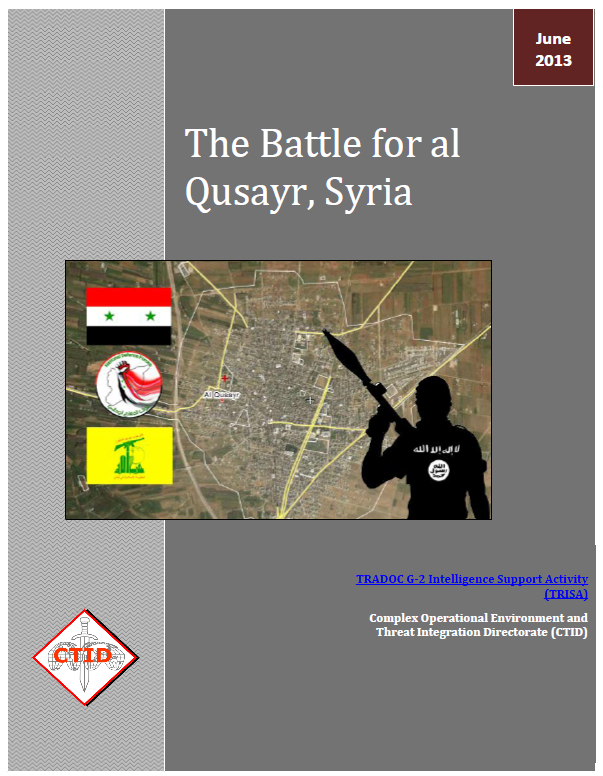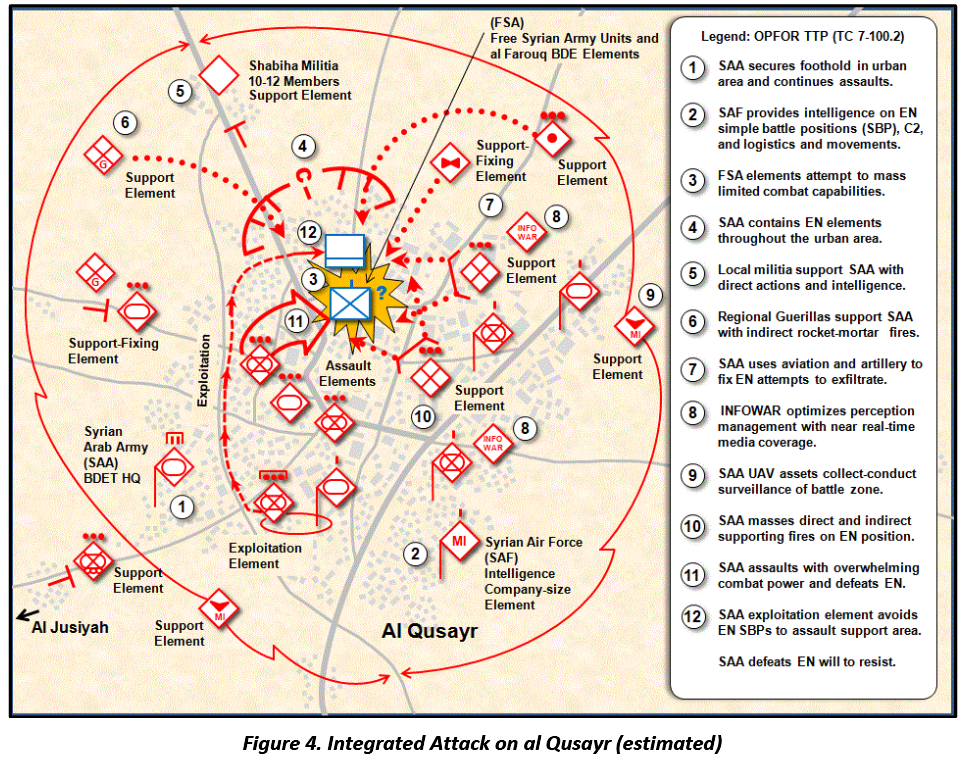The following report is part of a series produced by the TRADOC G-2 Intelligence Support Activity (TRISA). While the reports contain no control markings, they are not released publicly.
Threats Integration Team Threat Report
- 15 pages
- June 2013
The al Qusayr area of operations is a critical logistics hub for the rebel forces fighting against the Syrian government known as the Free Syrian Army (FSA).
A number of external actors and international terror organizations have joined the fight in the al Assi basin on both sides of the conflict.
The al Assi basin and the city of al Qusayr can be considered critical terrain and key to the future outcome of the conflict in Syria.
Conventional and unconventional as well as irregular forces are all present in this area and are adapting tactics in order to achieve a decisive outcome for their cause.
…
Al Qusayr, a village in Syria’s Homs district, is a traditional transit point for personnel and goods traveling across the Lebanon/Syria border. Located in the southern half of the Orontes valley known as the al Assi basin, its proximity to northern Lebanon has made this region an important logistical area for the rebel forces of the Free Syrian Army (FSA) and the Syrian Arab Army (SAA), in what has become known as the Homs front. A typical border region, the al Assi basin’s inhabitants are multinational as well as multi-ethnic with a complex makeup of Sunni, Shia, Alawi, and Christian religions that claim both Lebanese and Syrian Citizenship. Due to the proximity to the border region, and the main north and south highway from Homs to Damascus, al Qusayr is a pivotal point in the Syrian conflict for both the FSA and the pro-regime SAA.
Weapons and materiel support from Lebanon to Syria moves via the Bekaa valley into al Qusayr. In order to maintain their lines of communication with Sunni sympathizers in Tripoli, Lebanon, the FSA uses a network of rural and urban inhabitants to act as couriers, scouts, and transporters to get supplies and weapons to the battle zones in Homs and Damascus and to transport wounded out of the combat zone. As the fighting continues in al Qusayr and the rest of the Homs district, Sunni families wait on the other side of the border in Lebanon to support the fight and to get news about their property. Islamic groups such as Fatah al Islam had been noted to be operating in al Qusayr providing expertise on explosives and other terror tactics.
Support in the area is by no means restricted to the Sunni insurgency and the FSA. The Shia population, which is thought to be mainly rural, as well as many Christians, tend to support the SAA and the regime, and may be providing intelligence on the FSA and sympathizers in the region. The highway from the large port town of Tartus to the Syrian capital of Damascus goes through Homs City and the al Assi basin, making it an important supply route for the Syrian government and government security forces. To control Homs is to effectively control the link from Damascus to the Mediterranean. Control of Homs City will hinder coordination between northern and southern Syria substantially. Activities in recent months by the terrorist organization Hezbollah indicate that the area is one of the main regions for foreign support to the al Assad regime. Shia families have also fled to nearby Lebanon and are waiting to see who will win the war before going back to claim their property. Due to the importance of the region, both sides have struggled to maintain control since the beginning of the Arab spring protests in 2011.
When anti-government protests turned violent, pro-government forces relied on force to control the situation. This escalation of the conflict provided the rebel forces both a justification for their actions and a cause for foreign fighters (mainly from Lebanon) to enter into the battle. As the threat intensified, the government was able to increase its activities in the name of self-defense, and the insurgency took root in Syria. Neither side had the experience or resources to take the conflict to a culmination without assistance from their respective benefactors. The al Assi basin, with its access to Lebanon, as well as its access to the Alleppo-Homs-Damascus corridor, became a key area of interest for both sides in the conflict.
…


